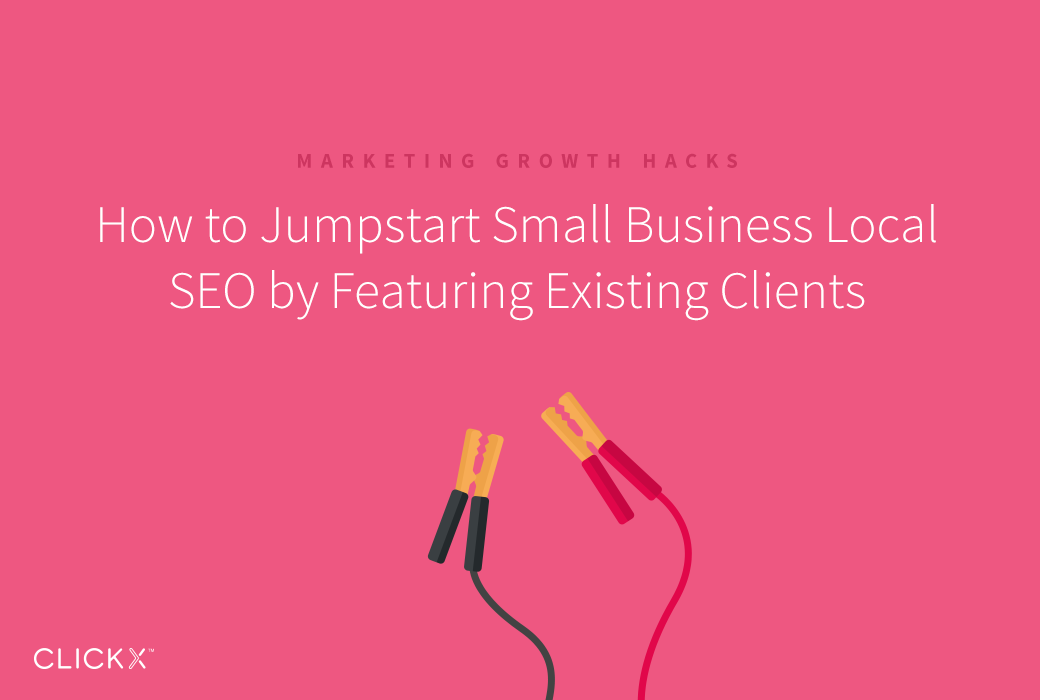How to Jumpstart Small Business Local SEO by Featuring Existing Clients
Some days it seems that there is only so much you can do to boost your business’ local SEO rankings, but a bit of clever content marketing can go a long way.
By featuring existing clients, you can not only boost your local SEO rankings by discussing relevant local topics, but build better relationships with your clients by making them feel special. To top it off, you may find they’ll refer traffic to their feature on your website for you.
You’re about to learn how to target the right clients and structure your customer feature posts to hit all the sweet spots for your local SEO rankings. It’s a lot simpler than you might think!

How Do Your Existing Clients Help Local SEO?
Your company has a lot of local clients, and those clients are most likely in your starting target territory for local SEO. By writing content about them, those posts will start showing up in search results and strengthen your association to a specific location with Google’s rankings.
[Tweet “Local SEO is boosted when your content is relevant to the local area.”]
As if that wasn’t enough, those local clients may even be flattered enough to link back to your site, and it is not unethical or unnatural to encourage them to do so! With these types of legitimate and valid links from local businesses, you’ll gain an even stronger local reputation within Google’s local rankings.
In this post, you’ll learn to identify which clients to feature, and how to boost your local SEO (while making them feel good at the same time).
Choose the Right Clients to Feature
Now that you understand the premise for this exercise, you’ll want to review a few must-have traits for the client selection process.
This is the easy part. Each featured client should:
- Be within your target geographic range.
- Be happy (delighted ideally!) about your services.
- Be willing to do a short interview and give you a testimonial (via email is fine).

How to Create Your Feature for Maximum SEO Impact
After curating a choice list of local clients who are happy with your work and willing to be featured on your website, you need to design these features to best strengthen your local SEO results. You do this by ensuring that you’ve covered the information relevant to your area throughout each feature.
Let’s say that Bob Saget (no relation to the celebrity) is a coffee shop owner in Los Angeles, and he’s a past client of yours. Your company is called Acme Roofs.
We will craft an example feature for Bob, to help you learn how to do this for yourself. Substitute the specific details with the appropriate information about you, your clients, and your target local area.
Introduce the Neighborhood
Questions to ask:
- “What range of services does your café serve for the Los Angeles area, and how is it unique compared to local competitors?”
- “What attracted you to do business in Los Angeles? Is there a story behind the choice in location?”
- “What makes Los Angeles such a special place for you and your café?”
By including specific location-based questions, you’ll receive a lot of location-specific answers that will only enhance the relevance of your content to the target local area in rankings.
When you ask for rich history rather than dry details, Bob will give you an interesting backstory that captivates the imagination, rather than a boring read with no pull or originality.
Bob tells you, “Back in 1998, I realized that Los Angeles didn’t have a café that served the punk crowd just yet. I wanted to serve that niche, and so far, I’m still the only café hitting that market west of the boulevard.”
Describe Your Business’ Relevance to the Area
Questions to ask:
- “What is the story behind the roof damage your café suffered, and how did that lead you to us?”
- “Can you describe the moment you knew that we were the right choice for the repair job your café required? How did we stack up to competitors?”
Ask questions that lead to answers specifically detailing your business’ relevance in the local market. What local papers, magazines, or blogs did the client search through to find you? What competitors weren’t good enough for them, and why?
Bob answers, “Well, we searched through losangeles.craigslist.org and LA Times. I found yourself, NoCorp Roofs and Roofs Inc.—but your company showed a better portfolio and had much friendlier staff. Along with your lifetime guarantee, it was a no-brainer.”
These bits and pieces all start adding up to a lot of specific local knowledge that lean in your favor, both for SEO rankings and when new visitors doing the same research come across these reviews.
Include Local Photographs
Question to ask:
- “Can you provide photos of yourself, your café, or pictures of you with the repair work we provided you and/or how it has impacted your own customers?”
Bob sends you back a portrait of himself next to his baristas, a shot of the business from the street, and a snap of that repair job you provided.
Just throwing these photos up haphazardly isn’t going to benefit your SEO rankings. You need to optimize them! And we don’t just mean for speed either.
Include relevant ‘alt’ tags for each photo. For example, on the business photo, something like this may work: “Street view of local Los Angeles coffee shop, roof repaired by Acme Roofs.”
Use the name of your target neighborhood and/or city, with a description of the photo, and (if possible) include a quick reference to your own company related to why the photo is being shown in the first place. The end result should sound like a highly informative description of the photo.
Formatting the Final Feature
You can elaborate with more personal touches and a longer interview specific to your client and their business, but these are the essential questions to cover for your local SEO customer features.
You can conduct the whole process over email, and then publish the post in a question and answer format on your company blog. The best part is, most of the content is written for you!
Conclusion
Local SEO may seem like a one-time optimization, but you’ll get much better results by continuing to feature relevant, local information by using information about the jobs you’ve already completed.
By choosing the right clients to feature, and ensuring that you discuss relevant local information in those features, you can dramatically improve your local SEO.
Have you tried featuring clients before? What has worked best for you to improve your local SEO rankings? Tell us more in the comments section below!
Image credits: Selena N. B. H.




